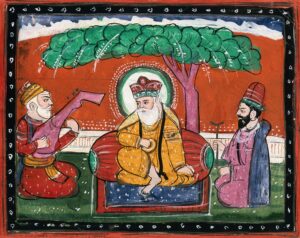Guru Nanak Dev Ji, the founder of Sikhism and the first of the ten Sikh Gurus, was born on April 15, 1469, in the village of Talwandi, now known as Nankana Sahib in Pakistan. His father, Mehta Kalu, was a local revenue official, and his mother, Mata Tripta, was a pious woman. From an early age, Nanak displayed signs of deep spiritual insight and wisdom. Unlike other children, he was not interested in worldly games or possessions and would often meditate or ask thought-provoking questions about God, humanity, and the purpose of life. His elder sister, Bebe Nanaki, recognized his divine nature early and supported him throughout his life.
As Nanak grew older, he resisted the social and religious practices of his time. He questioned the meaningless rituals of both Hinduism and Islam, the inequalities of the caste system, and the mistreatment of women. He believed in a formless, all-pervading God, whom he referred to as Ik Onkar (One Supreme Reality). At the age of 30, Guru Nanak had a profound spiritual experience while bathing in the Kali Bein river near Sultanpur Lodhi. He disappeared for three days, and when he reappeared, he was filled with divine realization. His first words were, “There is no Hindu, no Muslim.” This was not a denial of religion but a bold declaration that all human beings are equal, and true devotion is above any religious label.
Following this enlightenment, Guru Nanak embarked on four great journeys (Udasis) over the course of about 25 years. He traveled across India and into present-day Sri Lanka, Tibet, Mecca, Medina, and Baghdad. He walked thousands of miles to spread his message of peace, unity, equality, and love. During his travels, he engaged with people from various faiths and social backgrounds — sadhus, saints, qazis, yogis, and common folk. He challenged superstitions, caste-based discrimination, and empty ritualism. With him always was Bhai Mardana, a Muslim musician who played the rabab while Guru Nanak sang devotional hymns, which are today part of the Guru Granth Sahib.
One of Guru Nanak’s greatest contributions was his poetic and musical expression of divine truth. He composed over 970 hymns, which emphasized remembrance of God’s name (Naam Japna), honest living (Kirat Karo), and sharing with others (Vand Chakko). He promoted the concept of Langar, a free community kitchen where all people, regardless of caste or religion, could sit and eat together. He rejected priesthood and gave importance to Sangat (holy congregation) and Pangat (eating together) as powerful ways to establish equality and unity among people.
In 1522, Guru Nanak settled in Kartarpur, a town he founded on the banks of the Ravi River in present-day Pakistan. Here, he lived as a humble farmer, continued his spiritual teachings, and set up a community based on Sikh principles. Kartarpur became a center of spiritual learning, service, and communal harmony. As his end approached, Guru Nanak chose Bhai Lehna, a devoted follower, to be his successor. He renamed him Guru Angad, thereby starting the lineage of Sikh Gurus.
Guru Nanak Dev Ji left his mortal body on September 22, 1539. A beautiful legend surrounds his passing: when Hindus and Muslims both claimed his body for last rites, a sheet of flowers was placed over it, and when uncovered, his body was gone. Only flowers remained — which the Hindus cremated and the Muslims buried, symbolizing that Guru Nanak belonged to all. His teachings laid the foundation of Sikhism, a faith based on love, truth, service, and the oneness of humanity.















 Beyond its religious functions, the Gurdwara serves as a hub for community activities, bringing together the Sikh sangat for prayers, kirtan, and community events. The Gurudwara Baba Deep Singh affiliation underscores its dedication to upholding Sikh principles, contributing to the rich cultural tapestry of the Ganganagar area.
Beyond its religious functions, the Gurdwara serves as a hub for community activities, bringing together the Sikh sangat for prayers, kirtan, and community events. The Gurudwara Baba Deep Singh affiliation underscores its dedication to upholding Sikh principles, contributing to the rich cultural tapestry of the Ganganagar area.